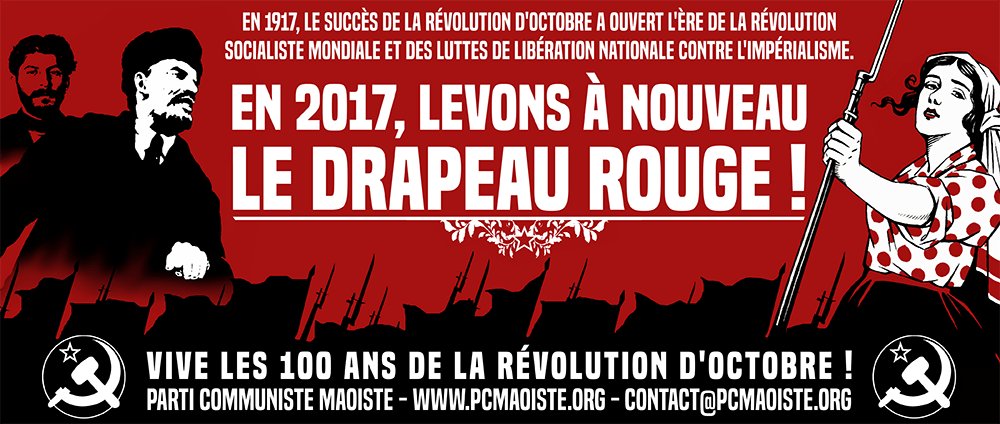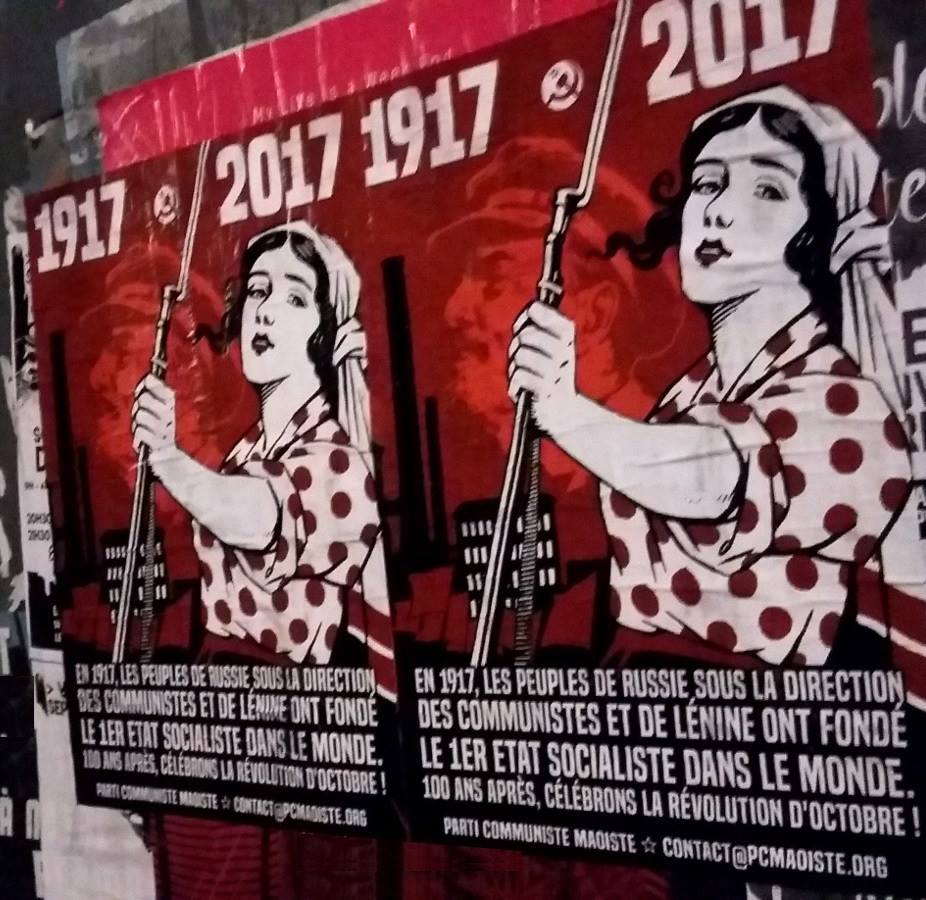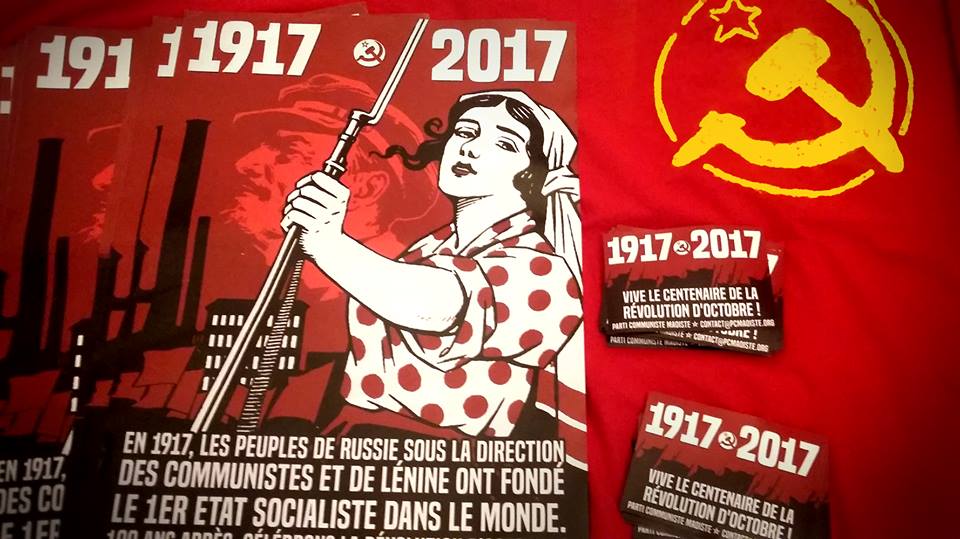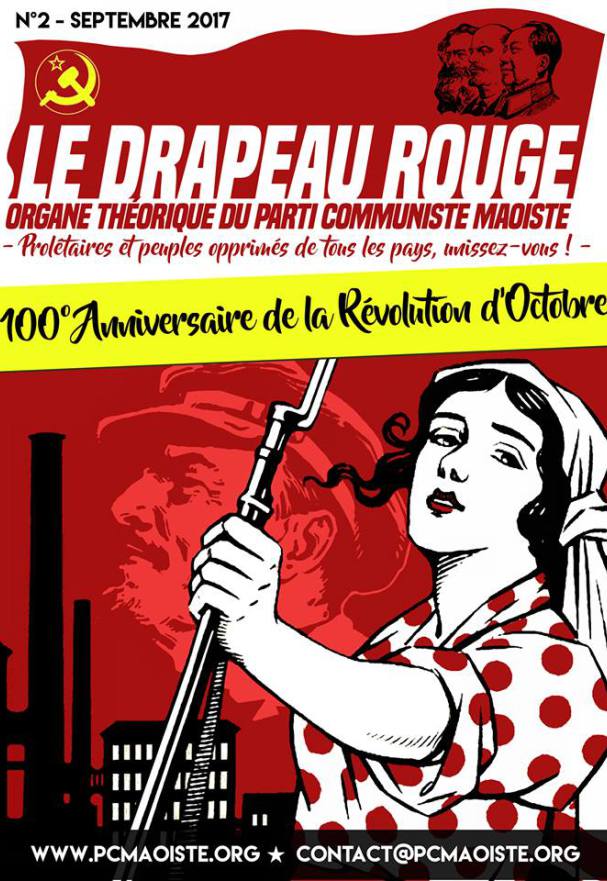PCM: Centenary of the October Revolution: Let’s raise the red flag again!
One hundred years ago the Great Socialist Revolution of October broke out – a thunderbolt in the middle of the First World War, an inter-imperialist war that led to the killing of the peoples of Europe for the interests of the various imperialist bourgeoisies wanting to divide the world’s wealth. It was in the midst of this war that the peoples of Russia lifted the red banner to reject the imperialist war and to overthrow tsarism and capitalism. The peoples of Russia led by Lenin’s Bolshevik Party turned their rifles against their exploiters and established the first socialist state in the world. They have shown to the proletarians of the world that it is not only possible to fight, even in the midst of the turmoil of the First World War, but that it is also possible to win and that this is the only answer the proletariat could give to the imperialist war.
This event has international significance. It showed the way to the proletariat and the oppressed peoples of Europe and the world. From the outset it made the bourgeoisie of Europe tremble, and they did everything, in vain, to crush this revolution which they feared would spread in the rest of Europe.
The Paris Commune in 1871, called the first dictatorship of the proletariat by Karl Marx, had already been a great victory for the international labor movement. The people of Paris chased the bourgeoisie to Versailles and had for three months organized its own power before being brutally massacred during the Bloody Week. It is from this experience that Karl Marx and then Lenin and the Bolsheviks learned valuable lessons to realize in their time the October Revolution, the work of the toiling masses of Russia.
The international significance of this event resonates as much in 1917 as today, one hundred years later in 2017. From the October Revolution the international proletariat has drawn immense lessons that still have an implacable validity today. Thus we affirm that celebrating the October Revolution should not be the result of nostalgia for an outdated era, nor should it be something folkloric, reduced to symbols of the past. To celebrate the Great Socialist Revolution of October is to grasp as firmly as possible its heritage to make it live today, to put it at the service of the proletariat — that is to say, to fight for socialist revolution today. Thus to celebrate the October Revolution is to study it in order to extract the universal aspects from the particular aspects (linked to historical circumstances). Each proletarian revolution contains a lot of universally valid lessons for the international communist movement, and the October Revolution has provided some of the most important lessons, along with the Revolution in China in 1949 and the Great Proletarian Cultural Revolution.
Studying the October Revolution is not limited to the final insurrection that led to the capture of the Winter Palace, the imperial palace and symbol of tsarism. To study the October Revolution is to study the whole period preceding the seizure of power by the Social Democratic Labor Party of Russia, through the Bourgeois Revolution of 1905 and of February 1917. It is to study the mode of organization of the Bolsheviks, the ideological struggle which they carried out, and the conquests made on this plane. It is also to study what happened after the Revolution, the civil war and the construction of socialism that continued until the beginning of the restoration of capitalism in 1956.

Today, we must raise again the red flag of proletarian revolution!
Today again, as there are no more socialist countries, the need for a world socialist revolution is felt everywhere.
Today, the ten largest capitalist groups make more money than the 180 “poorest” countries. Capital has never been as concentrated as it is today, inequalities have never been so great, and the world has never known so many proletarians as today. 147 companies, extremely interconnected by cross-shareholdings, represent 40% of the world’s wealth and in this list the ten most interconnected are financial groups (among them, the French group AXA).
The statistics produced by Oxfam in 2015 once again revealed the incredible level of inequality in the world, with the richest 1% possessing more than 99% of the world’s population possess. While global wealth has never been greater, it has also never been so concentrated. A tiny minority, the parasitic class of the financial bourgeoisie, shares the profits and superprofits generated by proletarians around the world who face exploitation and oppression. As a result, under-nutrition and malnutrition as well as lack of access to safe drinking water continue to kill millions of people. In the world every year, capitalist exploitation causes more than two million deaths from work-related accidents. The destruction of the environment, i.e. the capitalist ecocide, causes immense damage to the health of millions of people every day; an incalculable number of workers are victims of industrial diseases, especially in the oppressed countries. Similarly, millions of people do not have access to education, do not have access to healthcare, nor to decent housing (we are talking about nearly a billion people living in slums) …
Regarding the situation in France, in 10 years there will be more than 600,000 additional poor folks according to official definitions. There are more than 6.7 million people unemployed. According to the Abbé Pierre Foundation, poor housing conditions affect 4 million people and more than 12 million people are in a “situation of fragility” with their housing (rent representing a 56% burden on the household incomes of the most poor), more than 140,000 people have no homes, and evictions with recourse to the police force more than doubled in15 years. At the same time there are nearly 3 million empty dwellings. While today the CAC 40 records record profits, workers know an increasing precarity with a Macron government on a war footing against social rights, and the XXL Labor Law pursuing and amplifying the anti-worker and anti-people PS [Socialist Party] government. In the face of these attacks on the working class, of course, the government makes gifts to the rich, for instance with the removal of the ISF [Solidarity Tax on Wealth] all the while reinforcing the repressive arsenal of the state.
 We have attempted here to draw a very brief account of the situation in the world and in France. To understand these inequalities, to understand why they have only worsened and can only worsen without a socialist revolution, we must understand what capitalism is and what imperialism is, the origins of exploitation and misery that we find today in the world.
We have attempted here to draw a very brief account of the situation in the world and in France. To understand these inequalities, to understand why they have only worsened and can only worsen without a socialist revolution, we must understand what capitalism is and what imperialism is, the origins of exploitation and misery that we find today in the world.
Lenin in Imperialism, the Highest Stage of Capitalism (1916), defined for the first time what imperialism and its five fundamental characteristics were, the first of which led to the four others being “the concentration of production and capital reached a degree of development so high that it created the monopolies, whose role is decisive in economic life”. By entering its imperialist phase, capitalism moves from liberal capitalism (where competition prevails between firms) to monopoly capitalism (where large monopoly groups formed around banks control most of the economy). Imperialism has divided the world in two: between imperialist countries (of which France is a part as well as today the United States, China or Russia for example) and the oppressed countries. The imperialist countries are the ones from which the big monopolies come; the latter need to export their capital to the oppressed countries to maintain their rate of profit. As the division of the world between the imperialists is already complete, the imperialists must use war to monopolize parts of the market, that is, to gain domination over oppressed countries. Thus the First World War was the consequence of imperialism, just as today the wars in Afghanistan, Syria, Iraq etc. are the consequences of imperialism.
Lenin also teaches us that imperialism is the phase of capitalism in decay. In the time of imperialism, capitalism is moribund and the situation is ripe for the proletarian revolution. The three fundamental contradictions at the time of imperialism are: between imperialist powers and oppressed nations, between the bourgeoisie and the proletariat, and between the imperialist powers themselves (inter-imperialist contradiction). The October Revolution broke out in a weak link among the imperialist countries (Russia was then a backward capitalist country) opening the era of the world socialist revolution and the struggles for national liberation, an era in which we are still today. And we see that today these three fundamental contradictions of imperialism only sharpen more and more, everywhere in the world.
So we see the importance of the October Revolution not only in its time but still today. The October Revolution opened a breach against the world imperialist system and from this first breach we inherited many lessons.
The great legacy of the October Revolution
To study the legacy of the October Revolution is to study the gains made by the proletariat and the peoples of Russia in their struggle against tsarism and capitalism and in their struggle for the construction of socialism. These struggles were carried out under the leadership of the Bolshevik Communist Party and were synthesized in Leninism, the second milestone of Marxism, which Leninism develops in its three fundamental components: scientific socialism, Marxist political economy, and dialectical and historical materialism.
We present here some important lessons learned from the October Revolution; this does not exhaust all we can learn from the experience of the Bolsheviks, it is only to present some important conclusions which are still invaluable in our struggle for socialism. To study this subject in greater depth, we invite you to consult the latest issue of Drapeau Rouge, the theoretical organ of the PCM, devoted to the Centenary of the October Revolution.
A Party to lead the Revolution
 The struggle of the Bolsheviks gave to the proletariat a precious tool in the conquest of power against the ruling class: the Party of a new type as theorized by Lenin. The Party of a new type is the form taken by the vanguard of the proletariat to lead the revolution.
The struggle of the Bolsheviks gave to the proletariat a precious tool in the conquest of power against the ruling class: the Party of a new type as theorized by Lenin. The Party of a new type is the form taken by the vanguard of the proletariat to lead the revolution.
When we speak of the vanguard of the proletariat we are not referring to an enlightened minority of intellectuals cut off from the masses who would like to impose their theory on the people. The vanguard of the proletariat is the most advanced and determined elements, those who have the highest degree of ideological and political awareness and who are ready to give themselves entirely to the revolution. The proletariat is objectively the revolutionary class as it is the class which leads the socialist revolution and it is the class that in freeing itself will free all the other classes; it is through the proletariat that class division is done with. This does not mean, however, that in the proletarian class every person is revolutionary. Class consciousness must develop in order for the proletariat to become aware of its interests as a class, and this development proceeds in an uneven manner. In the working class, therefore, we find communist workers and reactionary workers, the former are advanced elements while the others are backward elements in terms of class consciousness.
The Party must therefore bring together the advanced elements because they are the ones who direct and lead the revolution. Party members are forged in the fire of class struggle and ideological struggle. The Party of a new type is a party for making revolution, thus it must be strong enough to overthrow the bourgeoisie. It therefore needs iron unity and iron discipline. The Party’s organizational principle is that of democratic centralism. This simply means that before a decision is taken the debate is open so that the struggle between two lines can be short and the correct line can be adopted; but once adopted, everyone, regardless of their individual position, must implement the decision. If the decision leads to failure a criticism must be made to rectify.
The Party of a new type, Lenin tells us, is the general staff of the proletariat. It must have an overview of the situation to make the right decisions and it must be relentless to face down repression and lead the revolution to its conclusion.
This Party of a new type is still the kind of Party the proletariat needs today. How can one overthrow the ruling class, its army, its police forces and its government without having a Party prepared to do so? Determined and disciplined activists are needed, who link theory and practice, and who become increasingly connected to the masses. It is the Party that gives the structure to form such activists, to form combatants and revolutionary fighters.
Mao deepens the question of the Party and deepens the question of two-line struggle and its manifestations as well as the question of the mass line and the necessity of the three instruments to make the revolution: the Party, the United Front and, and the People’s Army.
The dictatorship of the proletariat and the construction of socialism
Lenin on the question of the State starts from where Marx left off with his important conclusions from the experience of the Paris Commune of 1871. Marx clearly defined the Paris Commune as the first example of the dictatorship of the proletariat. In his book The Civil War in France, by analyzing the Paris Commune, Marx draws a conclusion of universal validity for the proletariat: we cannot be content to take over the ready-made state machine and turn it to our purposes. One must destroy it from top to bottom. It is therefore a question of completely destroying the old bourgeois state to build a new one, a socialist state under the dictatorship of the proletariat. In The State and the Revolution, the most important Marxist text on the question of the state, Lenin explains that the state is always a class instrument, that the purest of the bourgeois parliamentary democracies remains a dictatorship of capital and against this state, the dictatorship of the proletariat will therefore always be infinitely more democratic.
This is opposed to all the electoral illusions that say one could take over the state by elections and suddenly direct it on behalf of the working class. As Marx and Lenin have asserted, and as the history of the class struggle has always shown, the only way to overthrow the ruling class is through violent revolution to strip it of power and to establish by force a new power, a proletarian power.
After the seizure of power, the Bolsheviks and the popular masses had to struggle to build socialism for the first time. It was first necessary to defend at all costs the revolution against the whites who, aided through imperialist intervention, wanted to restore the monarchy. The construction of socialism in the USSR lasted up to the 1950s and provided rich lessons for communists around the world. As the first socialist state in the world, the Bolsheviks did not have any manual to follow or experience on which to rest (except that of the Paris Commune), and so errors were thus necessary in order to learn. It is based on the experience of the USSR, in analyzing it critically, that Mao will deepen the question of the construction of socialism in China, rectifying important mistakes made in the USSR, especially apropos the relationship between heavy and light industry, the transformation of social relations through the transformation of consciousness, the continuation of the class struggle under socialism, etc.
In the light of the experience of the revolution and the construction of socialism in the USSR and China, it is clear that the dictatorship of the proletariat in France will necessarily take different forms. We draw important lessons from these two revolutions concerning the construction of socialism and we must put these lessons at the service of the construction of socialism in the concrete conditions of our country.
The fight against revisionism and opportunism
 “Without revolutionary theory, no revolutionary practice,” says Lenin. And how is revolutionary theory established? In the heat of the class struggle, in the struggle for socialism and thus through its base in revolutionary practice. If the October Revolution was victorious in constructing the first socialist state in the world, it was because it was based on a strong, effective and tested revolutionary theory. A revolutionary theory which is synthesized in Leninism, the second stage of Marxism which went on to serve as an example to the proletariat and oppressed peoples of the whole world. This revolutionary theory, which allowed the victory of the socialist revolution in Russia and the construction of socialism, was forged in a constant struggle against revisionism and opportunism. That is, Leninism was forged in a struggle against those who rejected or distorted the basic principles of Marxism. It was an unfailing defense of Marxism against any deviation from the right or so-called “left”.
“Without revolutionary theory, no revolutionary practice,” says Lenin. And how is revolutionary theory established? In the heat of the class struggle, in the struggle for socialism and thus through its base in revolutionary practice. If the October Revolution was victorious in constructing the first socialist state in the world, it was because it was based on a strong, effective and tested revolutionary theory. A revolutionary theory which is synthesized in Leninism, the second stage of Marxism which went on to serve as an example to the proletariat and oppressed peoples of the whole world. This revolutionary theory, which allowed the victory of the socialist revolution in Russia and the construction of socialism, was forged in a constant struggle against revisionism and opportunism. That is, Leninism was forged in a struggle against those who rejected or distorted the basic principles of Marxism. It was an unfailing defense of Marxism against any deviation from the right or so-called “left”.
This was particularly evident in Lenin’s struggle against the social-chauvinists who, at the outbreak of the First World War, took their stand behind the bourgeoisie of each country, thus systematically betraying the interests of the proletariat. This was manifested in Lenin’s struggle against Kautsky’s and Bernstein’s erroneous conceptions which led to legalism, reformism, class conciliation, and thus to social-chauvinism. This struggle marked the end of the Second International and the creation of the Third International grounded firmly against opportunism and revisionism. This struggle was carried forward by Stalin against right-wing and “left-wing” opportunists such as Trotsky, Bukharin, and Zinoviev who all one way or another considered the construction of socialism impossible in the USSR.
This struggle against revisionism and opportunism was continued and deepened by the communists in China with their struggle against the modern revisionists who advocated and implemented the restoration of capitalism in the socialist countries such as Khrushchev in the USSR and Liu Shaoqi in China. This struggle is one of the basic principles that every communist must take up with the slogan “in defend Marxism, fight against revisionism”. It is a constant struggle, one that does not stop until the establishment of communism.
Today this struggle manifests itself both in the struggle against the old revisionists–the communist pseudo-parties having completely reconverted themselves into social-chauvinist and reformist parties such as the PCF–and in the struggle against Trotskyist revisionism, unable to unite the communist movement and carrying with it only failure. But this struggle must also take a particularly acute form against the highest forms of revisionism. What is the highest form of revisionism? It is revisionism that attacks the Marxism of our time, that is to say Maoism, so these are the false Maoists, people who call themselves Maoist in words but who are revisionist in deed. This is the case with prachandism that ended the People’s War and its achievements in Nepal; this is the case with Bob Avakian and his so-called “new synthesis”; this is the case with all those who reject Maoism as the new, third, and higher stage of Marxism.
The fight for the liberation of women
Socialist women played a crucial role in the October Socialist Revolution. From the start they contributed to the construction of socialism and the struggle against tsarism and capitalism. They proved by establishing their own organizations that what men can do, women can do as well.
The October Revolution teaches us that revolution cannot be complete and cannot achieve its goal without women’s participation. Lenin declares that “The success of a revolution depends upon the degree of participation by women”. The proletariat cannot be liberated if women are not freed from patriarchal oppression at the same time. And vice versa as well: a complete liberation from patriarchy cannot take place without ending the class division of society, and this can only be accomplished by overthrowing capitalism.
With the October Revolution, a new era opened up for women in Russia. They conquered through the struggle many new rights, gaining legal equality with men. Nevertheless, the legal framework is not everything and it is the practice and the movement of women itself for their emancipation that is central.
Lenin explains this clearly:
“Laws alone, of course, are not enough, and we are by no means content with mere decrees.
In the sphere of legislation, however, we have done everything required to put women in a position of equality and we have every right to be proud of it.
The position of women in Soviet Russia is ideal as compared with their position in the most advanced states. We tell ourselves, however, that this is, of course, only the beginning.
Woman as a house worker is still oppressed.
To effect her complete emancipation and make her the equal of the man it is necessary for the national economy to be socialised and for women to participate in common productive labour.
Then women will occupy the same position as men.”
The Tasks Of The Working Women’s Movement In The Soviet Republic, September 22, 1919
“We say that the emancipation of the workers must be effected by the workers themselves, and in exactly the same way the emancipation of working women is a matter for working women themselves.”
The Tasks Of The Working Women’s Movement In The Soviet Republic, September 22, 1919
In the USSR, women’s rights, as well as the role of women in society in general, were considerably advanced compared to the capitalist countries. It is notably in the USSR that the 8th of March, the International Women’s Day, became a vacation day and was officially celebrated for the first time. Nevertheless, despite the advances, many setbacks would also take place later which cannot be neglected.
The question of women would be raised to a higher level during the construction of socialism in China where women waged an uncompromising struggle against patriarchy to participate fully in the construction of socialism.
Today, to be a communist is necessarily to defend and by all means to apply revolutionary proletarian feminism.
To be a Marxist today is to be a Marxist-Leninist-Maoist!
 We have seen how invaluable the legacy of the October Revolution is in guiding us on the revolutionary path today. The revisionists and opportunists always take only what they want from the legacy of the October Revolution by pretending that the great principles that emerged from it were done in particular and historical conditions, thus liquidating the concept of violent revolution, dictatorship of the proletariat, or democratic centralism. The communists do not deny an iota of this legacy and fully take it up it to apply it to the concrete conditions we face today, seeking thus to seriously advance towards the socialist revolution.
We have seen how invaluable the legacy of the October Revolution is in guiding us on the revolutionary path today. The revisionists and opportunists always take only what they want from the legacy of the October Revolution by pretending that the great principles that emerged from it were done in particular and historical conditions, thus liquidating the concept of violent revolution, dictatorship of the proletariat, or democratic centralism. The communists do not deny an iota of this legacy and fully take it up it to apply it to the concrete conditions we face today, seeking thus to seriously advance towards the socialist revolution.
Nevertheless, the construction of socialism in the USSR, as previously stated, was a historical first – it therefore had its share of errors and limitations due to it historical circumstances. The Revolution in China succeeded in passing beyond these limits, as the Chinese Communist Party under the leadership of Mao Zedong brought important victories to the proletariat in the struggle for socialism and took a new step forward with Maoism, the third stage of Marxism. Among these new contributions to Marxism, we must note the Great Proletarian Cultural Revolution to prevent capitalist restoration, as took place in the USSR; we must note the theorization of bureaucratic capitalism and the need for the New Democratic Revolution in oppressed countries as a necessary step towards socialism; there is the deepening of the dialectic with the unity of opposites as the fundamental law of the dialectic from which all the other principles derive; there is also the prolonged people’s war as a military strategy of the international proletariat.
No Marxist today can ignore Maoism as the third stage of Marxism after Leninism. No one can stop history at Leninism and pretend that nothing happened afterwards; to act in this way is to practice revisionism and not Marxism. To be Marxist, to be Leninist, also means to be Maoist.
One can not grasp Lenin’s legacy without grasping Mao’s legacy. To be a Marxist today, to be a communist, is to be a Marxist-Leninist-Maoist.
To continue on the path of the October Revolution today is to develop the revolution in our country, it is to build a Party of a new type by applying the Marxism of our time, that is Maoism, endowed with the universal strategy of proletariat: protracted people’s war. Those who continue on the path of the October Revolution today are the Communist Parties leading People’s Wars, such as those in India, Philippines, Turkey or Peru. These are the ones who everywhere rebuild Communist Parties on the basis of Marxism-Leninism-Maoism as a militarized Party and prepare the Protracted People’s War, according to the conditions of their country.
In the French state, to continue on the path of the October Revolution means to join and strengthen the Maoist Communist Party to advance towards the Protracted People’s War!
Long live the Centenary of the Great October Revolution!
Long live Marxism-Leninism-Maoism!
Source: http://www.pcmaoiste.org/communique/centenaire-de-la-revolution-doctobre-levons-a-nouveau-le-drapeau-rouge/

